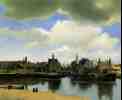![]()
 View of Delft
View of Delft
c. 1660-61 Oil on canvas, 96.5 x 115.7 cm; Royal Cabinet of Paintings Mauritshuis, The Hague
In an early review of the exhibition, curator Arthur Wheeler was quoted as asserting that the show would not have been held had View of Delft not been made available. Although I had always considered it a remarkable painting, this claim still seemed somewhat extravagant. Then I saw the exhibition. View of Delft is prominently hung in the center of the second room. It is without a doubt one of the most captivating, compelling works of art I have ever seen. It has an overwhelming presence, conveying the perception that you are beholding a cityscape more real, more substantial than anything you could possibly encounter in the outside world. One of the pleasures of Vermeer's art is its accessibility. You can stand in awestruck wonder before this painting without having to analyze it, without needing to understand it on an intellectual level in order to appreciate it. Of course, when you awaken from your aesthetic reverie, it is only natural to want to understand how Vermeer could bring about such an intense effect.
The most significant effect is the lighting. Dark clouds overhanging the city cast the foreground in shadow. This not only calls attention to the vastness of the sky, but serves to draw the eye into the heart of the city, which is bathed in warm sunshine. Vermeer also used various textural effects to convey the physical presence of Delft. Anticipating Georges Braque by 250 years, he blended sand with the paint used to render the stone facades, bridge and roofs. In the tallest tower, Vermeer applied a thick impasto of yellow to accentuate the sunlit areas.
View of Delft is the only painting of Vermeer that lends itself to comparison with a known motif. As such, it offers valuable insight into his creative procedure. Study of contemporary topographical drawings and paintings of Delft reveals that Vermeer freely adjusted the cityscape in the interests of his composition. He made numerous changes that flattened the cityscape, reinforcing its frieze-like profile. By accentuating the horizontals of the buildings, walls and bridge, Vermeer gave the city added weight and solemnity.
X-radiograph and infrared reflectography show that in the original composition, the reflections of the twin-gated tower ended in the water. By later extending these reflections downward past the bottom of the canvas, Vermeer bound the city profile to the foreground. The reflections, functioning practically as shadows, anchor the mass of buildings to the near shore, forcefully integrating the composition.
In this painting, Vermeer achieved a sense of monumentality by subtle textural, lighting and compositional techniques. He moved beyond descriptive realism to create a mood that conveys the history and character of his city.
-- Mark Harden